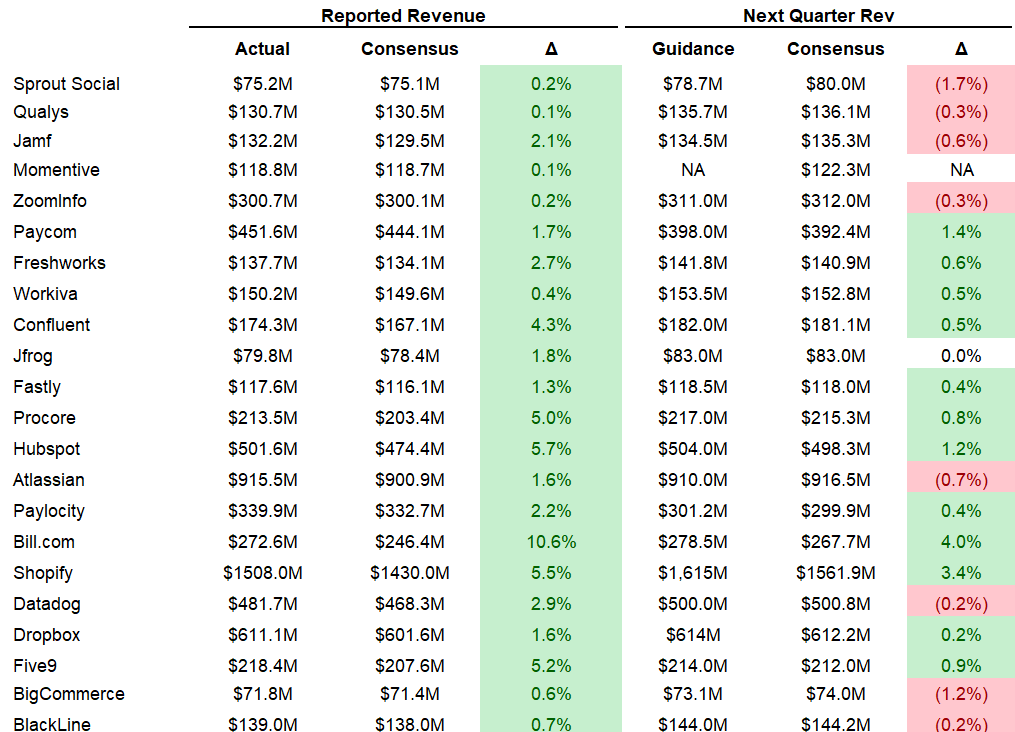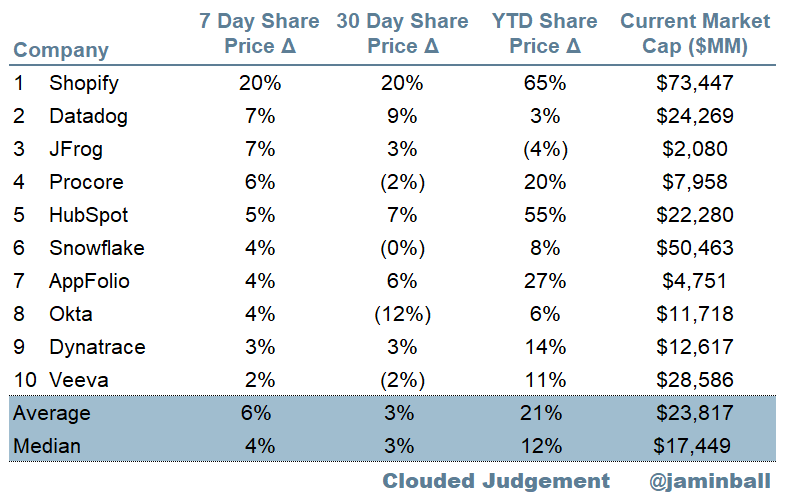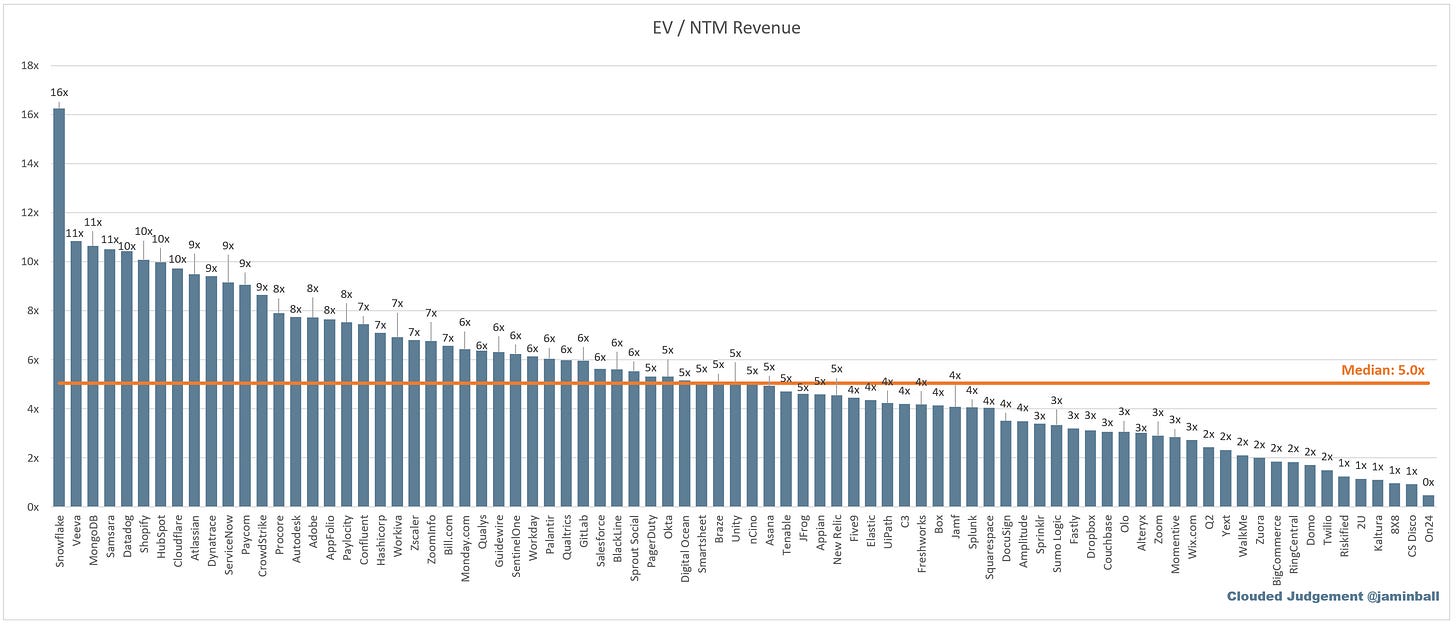Clouded Judgement 5.5.23 - Slowdown in Consumption Software
Every week I’ll provide updates on the latest trends in cloud software companies. Follow along to stay up to date!
Early Learnings from Q1 Reports
Another big week of software learnings. I’ll recap a couple main points on my mind below.
I think it’s fairly consensus that consumption software will be the first to rebound. The big question - when does this happen? When do we see a reacceleration? The real question here is when do the headwinds of optimizations become smaller than the tailwinds of expansion. Growth typically comes from two vectors - new customer acquisition and expansion of existing customers. So far, the biggest macro headwinds have hit the latter much harder than the former. This is significant because what’s most important is all of these vendors (key consumption vendors are Snowflake, Datadog, Mongo and Confluent) are adding to their base of customers. So once the expansion headwinds subside, the tailwind will turn against a large underlying base of customers. This could also happen once we start lapping Q3 ‘22 when the optimization headwinds really kicked in.
One chart to illustrate what this reacceleration could look like is below. I’ve charted Datadog’s quarterly YoY growth. As you can see, consumption fell off quickly with Covid, and then rebounded very quickly. The rebound was extreme given what we saw in the broader software demand environment (big pull forward), but the concept remains. When the current macro environment eases up we could see a similar effect (but to a lesser extent)
So what have we learned so far? Microsoft was more constructive that the optimization headwind would return to normal in the next couple or few quarters. Amazon not so much. Datadog said “we don't see anything that gives us confidence that we can call an end to optimization next quarter or the quarter after that." JFrog told us that “despite customers taking steps to be more efficient in their cloud consumption, we saw acceleration of cloud usage in both pay-as-you-go and annual SaaS customers.”
To sum it up - there’s no consensus. What does seem clear - optimization headwinds are not getting stronger (good thing!). We may be in the first phase of things settling before they re-accelerate. I’m excited about the potential for a more constructive environment as we get closer to year end.
One thing that is clear - we’re really seeing a slowdown (should be no surprise to anyone…). Yes we see it in the YoY growth rates, but it’s more stark when looking at the trend of net new ARR added each quarter. Below I’ve charted Datadog and Confluent’s net new ARR each quarter for the last 7 quarters. It’s a bit of a swag since these companies don’t disclose quarterly ARR, but it’s directionally accurate. When we see this trend reverse is when I’ll start to get excited that things are starting to turn
Are Forward Estimates Derisked?
In Q4 earnings ~3 months ago companies gave us a first look at guidance for the full year. Most companies took a very conservative approach and set a low bar. Now that we have one more quarter of data, how are companies full year guides changing? Are the feeling better, worse, or the same? The chart below shows how full year guides changed from Q4 to Q1 (I’ve only included companies who guided the full calendar year).
As you can see, we really haven’t seen much change in full year guides (Cloudflare stock was crushed after they lowered their guide after sounding very confident in their guide 3 months ago).
What does this suggest? 2023 numbers are probably close to fairly de-risked. I don’t see 2023 numbers coming down much from where they are today. Interest rates also feel like they’ve peaked (or close to it). So a lot of the headwinds from the last 18 months are starting to go away.
So what’s the risk? 2024 numbers. There does seem to be an element of re-acceleration baked into 2024 numbers. If those estimates assume re=acceleration starts in the back half of the year, but it doesn’t really start until end of year / early next, then 2024 numbers will need to come down as they did for 2023 numbers from Fall ‘22 through early ‘23. To the extent the re-acceleration gets pushed further and further out, 2024 numbers will probably need to come down. I’m not saying this will happen, I’m just laying out the risk.
In summary - Datadog and Confluent this week delivered a much better than feared set of Q1 results. Consumption trends in the quarter exceeded expectations, but management teams are still cautious about the rest of the year. Snowflake and Mongo will give us an additional peak into consumption trends when they report towards the end of May. The good news is two big challenges for software valuations seem to be largely behind us (interest rates, and worsening consumption patterns). We’re getting closer!
Quarterly Reports Summary
Top 10 EV / NTM Revenue Multiples
*Companies who reported this week don’t have updated estimates yet
Top 10 Weekly Share Price Movement
Update on Multiples
SaaS businesses are generally valued on a multiple of their revenue - in most cases the projected revenue for the next 12 months. Revenue multiples are a shorthand valuation framework. Given most software companies are not profitable, or not generating meaningful FCF, it’s the only metric to compare the entire industry against. Even a DCF is riddled with long term assumptions. The promise of SaaS is that growth in the early years leads to profits in the mature years. Multiples shown below are calculated by taking the Enterprise Value (market cap + debt - cash) / NTM revenue.
Overall Stats:
Overall Median: 5.0x
Top 5 Median: 10.7x
10Y: 3.3%
Bucketed by Growth. In the buckets below I consider high growth >30% projected NTM growth, mid growth 15%-30% and low growth <15%
High Growth Median: 6.8x
Mid Growth Median: 5.6x
Low Growth Median: 3.0x
EV / NTM FCF
Companies with negative NTM FCF are not listed on the chart
Scatter Plot of EV / NTM Rev Multiple vs NTM Rev Growth
How correlated is growth to valuation multiple?
Growth Adjusted EV / NTM Rev
The below chart shows the EV / NTM revenue multiple divided by NTM consensus growth expectations. The goal of this graph is to show how relatively cheap / expensive each stock is relative to their growth expectations
Operating Metrics
Median NTM growth rate: 16%
Median LTM growth rate: 25%
Median Gross Margin: 75%
Median Operating Margin (21%)
Median FCF Margin: 3%
Median Net Retention: 116%
Median CAC Payback: 37 months
Median S&M % Revenue: 47%
Median R&D % Revenue: 28%
Median G&A % Revenue: 18%
Comps Output
Rule of 40 shows rev growth + FCF margin (both LTM and NTM for growth + margins). FCF calculated as Cash Flow from Operations - Capital Expenditures
GM Adjusted Payback is calculated as: (Previous Q S&M) / (Net New ARR in Q x Gross Margin) x 12 . It shows the number of months it takes for a SaaS business to payback their fully burdened CAC on a gross profit basis. Most public companies don’t report net new ARR, so I’m taking an implied ARR metric (quarterly subscription revenue x 4). Net new ARR is simply the ARR of the current quarter, minus the ARR of the previous quarter. Companies that do not disclose subscription rev have been left out of the analysis and are listed as NA.
This post and the information presented are intended for informational purposes only. The views expressed herein are the author’s alone and do not constitute an offer to sell, or a recommendation to purchase, or a solicitation of an offer to buy, any security, nor a recommendation for any investment product or service. While certain information contained herein has been obtained from sources believed to be reliable, neither the author nor any of his employers or their affiliates have independently verified this information, and its accuracy and completeness cannot be guaranteed. Accordingly, no representation or warranty, express or implied, is made as to, and no reliance should be placed on, the fairness, accuracy, timeliness or completeness of this information. The author and all employers and their affiliated persons assume no liability for this information and no obligation to update the information or analysis contained herein in the future.

















Whats should be kept in mind is that cloudflare has a short sales cycle of typically less than a quarter. This way they see changes in the environment quicker than most of the other SaaS companies. Their surprise of the suddenly elongated sales cycles of 27% for new customers and 49% for the expansion of existing ones make me nervous.
They have seen those changes quicker than most of the others back in 2022, too.
There could be some surprises in the upcoming 1-2 quarters for some of our beloved SaaS companies.